Lessons From Afar
After a big transition, moving classes online has given professors new ways to connect to students and provide continuity in an uncertain time
Posted in: Education, University

What do virtual classrooms look like? The answer varies, but since the mid-semester switch to online instruction, faculty have become creative, adapting with digital tools for virtual labs, adding podcasts, adjusting with video streaming software for lectures and discussion, directing choirs on pitch in Zoom rooms, and even creating virtual space for mindfulness and self care.
But teaching through a pandemic calls for more than simply providing lessons from afar; it calls for additional compassion and patience.
Having the virtual classroom setting now inside the homes of both professors and students makes for some lighter class moments, like seeing the stuffed animals that adorn a childhood bedroom or being interrupted by children or parents or pets, who sometimes make guest appearances in the “classroom.”
The change also provides a window into the more challenging aspects of lives altered by stay-at-home orders, including students who struggle with a host of problems, from internet access to financial and mental health needs, to caring for sick relatives or being ill themselves.
Whatever their circumstances, about 21,000 students are trying to complete a spring term like no other.
“It’s too early to know definitively how successful we are at supporting students during the COVID crisis, but faculty are positive if cautious,” says Emily J. Isaacs, executive director of the Office for Faculty Advancement. “They report that students are coming to classes, although attendance is lower, and students tell them of family members who are ill, and even more frequently, out of work.”
During the past month, the Office of Faculty Advancement has presented nearly 40 online classes on best practices for remote teaching, attended by more than 1,000 faculty, Isaacs says. “The challenge now is to sustain the momentum.”
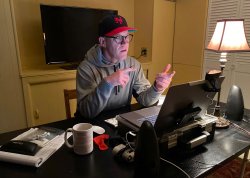
Navigating Hardships
While taking classes, many Montclair State students are working on the front lines of the pandemic, including first responders, nurses and public health professionals. They are essential workers, cashiers at the grocery store, teachers home schooling both their own children and those in New Jersey classrooms.
Assistant Professor Thomas E. Franklin says his experience as a journalist prepared him for this crisis. “I’ve been in situations where the unpredictable happened and you’re trying to function under the strain of an emotional world occurrence. You just figure out a way to still do your job and be productive.”
Franklin, a 9/11 Pulitzer Prize finalist, is not only adapting classes in advanced multimedia news production with tools available to students during a quarantine, he’s also documenting life in New Jersey amid the pandemic.
Like other professors, he’s also learning of the hardships many students are experiencing – students like Diana Ortiz, a senior majoring in Communication and Media Arts who juggles her course load with working full time as a unit secretary on a trauma floor at Robert Wood Johnson University Hospital to pay tuition.
The coronavirus is always on her mind, she says, whether she is at work or at home. At the hospital, “you don’t know what you’re walking into. Talking to nurses, and seeing their eyes, there is a lot of anxiety.”
Her biggest worry, Ortiz says, is bringing the virus into the home she shares with her parents. And while no longer commuting nearly an hour to campus, the stress at work and pressure of finishing the semester leave her more tired than usual. “Half the time, I’m in a daze,” Ortiz says. “My mind just isn’t there.”
Ortiz says she is grateful to the professors like Franklin who recognize what she is going through. “It goes a long way – the support you get, it goes a long way.”

Removing Barriers
“Faculty at Montclair State have always felt great compassion and even affection for their students, but perhaps more so than ever before, faculty are communicating this compassion directly to their students,” Isaacs says.
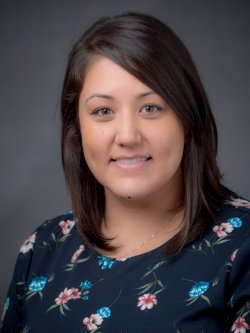
Pass/Fail options for undergraduates and flexibility of deadlines are among the ways the University and faculty are removing barriers as students transition to the online learning environment.
“That’s been a big thing for us,” says Rebecca Linares, an assistant professor in the Department of Teaching and Learning. “We’re trying to be mindful to not make any assumptions about what it means when a student doesn’t show up or doesn’t turn something in. Our students are navigating totally different realities right now and different responsibilities.”
The move to online classes has been easier for some courses than others. Assistant Professor Manveer Mann stepped in to take over a retail math course. “It was challenging enough for students that the math course had moved online, and now they had a new professor whom they had not met in person,” Mann says.
By offering one-on-one tutorial Zoom sessions she’s been able to alleviate some of the stress students were feeling. She also created YouTube video tutorials demonstrating how to solve sample problems so students could watch them as many times as they needed.

Teaching and Learning
“I have been teaching for many decades and I always argue that we never arrive as teachers. We always have new things to learn, new things to do,” says Professor Jaime Grinberg, department chair of Educational Foundations.
In reformatting a lecture hall with 100 students for a class that now needs to fit into the size of their phones and computer screens, Grinberg says he’s created new assignments, including adding documentaries, incorporating text messaging into discussions, playing a mix of musical genres as students enter the virtual classroom.
When technology glitches, he asks students to help out. “I’m teaching you something, and you’re teaching me,” Grinberg says.
Associate Professor Josh Galster from Earth and Environmental Studies typically draws during a class. To continue virtually, “I built a stand out of a rock and some legos – besides a geologist, I have kids – for my phone to record me talking while I draw.” Galster says he tried to use a tablet, but it wasn’t the same. “I’m trying to keep my hands out of the videos,” he jokes, “but I’m still learning.”
The continuity of classes has been important, observes María Cioè-Peña, an assistant professor in the Department Teaching and Learning. “It offers a space for us to maintain connection with our students, particularly during stressful, uncertain environmental situations. But because it’s in a crisis situation, [the mid-semester switch to teaching online] is very different than when you have orchestrated or planned from the very beginning.”
Essential Outcomes
Supporting the rapid preparation with the mid-March decision to move all classes online, the University developed a peer-to-peer model to share strategies and instructional technologies. The support includes developing a variety of ways for students to attend class, access content knowledge and demonstrate their comprehension.

Professor Pankaj Lal says he’s adapted classes in Earth and Environmental Studies with online presentations, web videos and online materials that are being made available freely by colleagues and organizations.
“I have learned that chats, where students are writing their thoughts and questions from some interesting perspectives, while live streaming the class has been quite engaging,” he says.
And since field work is restricted, Lal’s 20-member research group has channeled efforts into smaller work-groups doing modeling and analyses. “These research groups are interacting regularly and we are using screen sharing extensively,” he says. “Live discussions, working and collaborating on projects in real-time has been really helpful.”
Other strategies have included new ways to present information. Associate Professor of Musicology Laura Dolp converted formal papers into podcast assignments. “I felt that because students were now in potentially isolating environments that hearing each other’s voices in relation to course content was important. They can also conduct interviews with each other as part of the format, which encourages them to process the material together.”
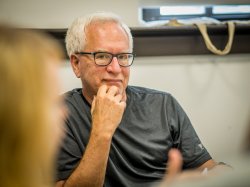
Professor Neil Baldwin says the switch to remote platforms, according to studies, is less smooth for freshmen than other students. “This was borne out to me when not one student wanted to shift to asynchronous classes – everybody wanted to meet at the same time and on the same day ‘like we always did’ and to do it on Zoom so they could see and hear each other and feel part of a group.”
Since moving his honors poetry remotely, Baldwin says the class has discussed, quite relevantly, “the lunatic, the lover and the poet” from Shakespeare’s As You Like It; Keats’ concept of “negative capability” in the context of the current global crisis; William Blake’s Proverbs of Hell; the poetry of Giacomo Leopardi; Thirteen Ways of Looking at a Blackbird by Wallace Stevens; and the haiku of Basho.
“The remarkable thing, for me,” Baldwin says, “has been the miraculous response of these young people to the power of poetry in a time of such adversity.”
In Sports Media and Journalism, students used the app Adobe Spark to create personal storytelling videos. The class bonded in sharing the work during a Zoom session, says Assistant Professor Kelly Whiteside. “We had great feedback, including from students who were on but had their audio and video off because they were either sick or taking care of young children. They chimed in with comments in the written chat section which I read aloud.”
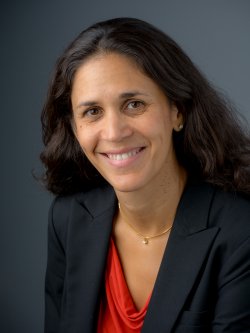
Associate Professor Tara George, head of Journalism and Television/Digital Media, assigned a documentary from the Sprague Library database accessible to all students.
“We cued up our films to start at the same time, and then we did a live chat through Canvas. It was a jerry-rigged version of Netflix Party, but it worked. And the discussion was thoughtful and a welcome distraction from the pandemic.”
Cultivating Mindfulness
Faculty say they’re finding ways to bring mindfulness – the practice of paying attention to a moment with openness and curiosity – into their virtual assignments in a variety of ways.
In a class on religions of the world, meditative practices were integrated alongside the introduction to Asian religions, students listening to a recording of chants to soothe their minds. “I’m trying to incorporate some of the things we’ve been learning as tools for potentially coping with this situation,” says Assistant Professor Kate Temoney.
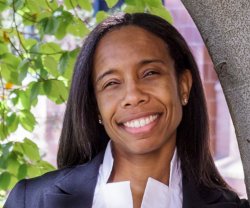
Faculty are also building in opportunities for self care, like asking students to go on neighborhood walks, to cook a meal, to reach out to a friend.
At the John J. Cali School of Music, some students are participating in optional mindfulness sessions in classes and rehearsal meetings. “For musicians, learning how to pay attention is the secret to effective performing. You have to be self-perceiving and world-perceiving, and completely embodied and free of unnecessary tension,” says Professor Heather J. Buchanan.
“It’s become so much more important in the last few weeks,” Buchanan says.“ I am trying to help students cope and find a sense of purpose through meaningful learning experiences. Also encouraging them to understand that when this situation is eventually over, hopefully it will be a small blip in the context of a whole life. But for most students, it is tremendously overwhelming right now.”
Story by Staff Writer Marilyn Joyce Lehren
You may also like:
- Stay Positive: Tips and online resources to help you take care of your mental health.
- Online Class Advice: How to Succeed – Advice from one of your professors.
- Distance Can’t Keep Them Apart – Students find ways to connect online to socialize, stay fit and maintain a sense of “campus life.”
